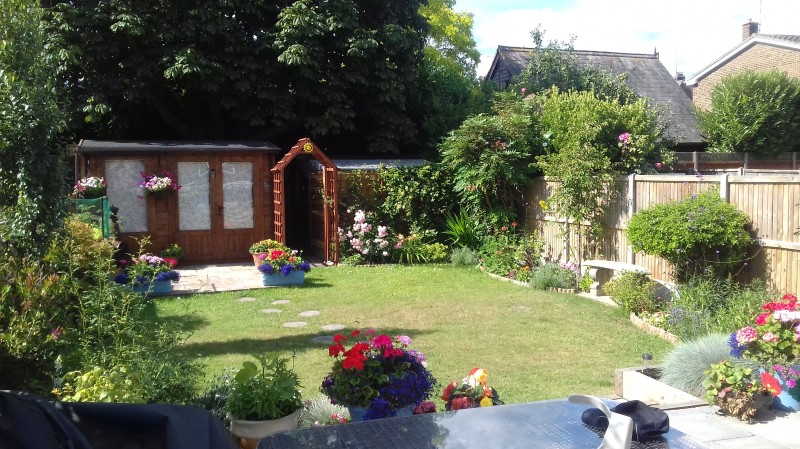You are here: Uses for a Garden Room
A garden room can be put to a diverse range of uses, and being distinctly separate from the main house is the key benefit it confers.
It can provide refuge in the form of a quiet space to read, study or work. On the other hand, it can be a music room or children’s playroom, where members of the household can let loose without disturbing others with mess, noise or both. It can provide a dedicated space to practise a hobby or craft and to store the mountain of equipment that often goes alongside. Perhaps most importantly, it affords you the luxury of a space away from the distractions of the household.
Put simply, a garden room can be perfectly tailored to the needs of the individual or family within the restrictions of Permitted Development or Planning Permission

Playroom/ Games Room
Although it is true many garden rooms were either recommissioned or built as a home-office during the Covid-19 pandemic, rather than providing a separate space to work, a garden room can also provide a distinct place for play. Many parents would jump at the prospect of housing all their children’s toys in a separate building, preserving space and quiet in the main house and allowing children to let loose.
Initially used as a games room housing a table tennis table, mum-of-five Sam says their garden room was repurposed as “a big and messy playroom” for the smallest children in their brood. The playroom houses a sandpit, a play canal/waterway set, fingerpainting paints and table, a slide and a bubble machine. The floors are washable so the mess created by these toys is not a problem. Some of the older children also use the space for spray-painting art projects.
Sam says the main benefit of this room is that toys so often relegated to fair-weather use can be used all year round. For example, a garden slide has been brought indoors and set over a tuft run to ensure a soft landing! Mess is contained in an easy-to-clean area (with laminate flooring and oilskin cloths over the tables for painting), so there is no rush to clear up when guests are due.
Bar
Although a garden room can provide an ideal way to put the noise and clutter associated with children away from the house, it can also provide a refuge for adults. Parents-of-three Ben and Sandy knew they wanted a garden room for themselves when they moved into a property with ample outdoor space.
“We wanted a room for entertaining, that was usable in all weathers and separate from the house so that we were far enough away from the children!” Their room includes a well-stocked bar, coffee table, a small seating area and DJ-decks.
Once they settled on a garden room, the process was easy: “We checked the rules for permitted development of these buildings with the council. We had a to make sure it was under a certain height and a certain distance from the boundary. There were no planning headaches or appeals/repeat applications.”
The bar has an insulated roof and insulated flooring, and 45mm thick wooden walls. Coupled with a small electric heater for the bar area in the coldest weather, the building is comfortable all year round. Needless to say, the home-bar became an instant hit amongst their friends.
During national lockdowns, Ben and Sandy weren’t tempted to convert the bar to a home office. Although it was being used less - with no chance of entertaining friends for the majority of 2020 - they were committed to keeping it as a bar and ensuring that, when restrictions eased, they were ready to welcome their friends round.
Home Office
Throughout the Covid-19 pandemic, one of the most popular uses of garden rooms has been as a designated home-office space. With many businesses adopting remote working either in entirety or in part, more and more home workers need a space that allows them to work from home productively whilst making sure work does not encroach on their personal life and other members of the household.
Independent from the home, a garden room office has a clear benefit in terms of helping to preserve a healthy work/life balance. Professional business is kept in one area that cannot physically overlap with the personal. Although not quite equivalent to a daily commute, moving to a separate building provides a tangible boundary between work and home, one that is easily lost if working from a spare bedroom, converted garage or the dining room table.
This separation was the main reason that Martin built a garden room for his home office. In 2015, his work relocated and he was offered the opportunity to work from home three days a week. Martin says, “I wanted to keep my work and home space separate. There’s nothing worse than waking up in the morning and seeing your desk in the same room- I tried it!”
He had the plan clear in his mind, and the specification was a typical home office: multiple power points, a hardwired internet connection and furnished with a couple of desks and comfortable desk chairs.
When it came to construction, Martin took the job on himself. “I looked up the rules on wooden buildings and roof heights etc., and made sure that my neighbours knew what I was doing and had no objections before I started. It came as a kit and had to be built, plank by plank and nail by nail. It was quite a lot of work. The hard part wasn’t the construction itself, but preparing the ground and laying the base. That was tough, as was getting two coats of paint on. However, I did it all by myself, including the mains wiring which I had certified and commissioned by a professional because I didn’t want it catching fire!”
Martin’s case brings to light some important factors to consider when planning your garden room home office. Firstly, ensure you include sufficient insulation to make the room comfortable to work in all year round. Martin says “I was glad I added lots of extra insulation in the roof and floor, as well as double glazing. With a small electric heater, it warms up very quickly. I loved the cosy midwinter days when I was out there watching the snow falling down and knowing that I didn’t have the worry of driving to work and back.”
Secondly, give plenty of thought to the working environment you will end up with and how this will serve you. Some of the more basic needs, such as warmth, light and noise insulation quickly spring to mind. Others, such as how your office will look and feel in your garden, might not. How you would feel when sitting out in the garden of an evening, seeing your office and then pondering the deluge of emails you’ll face on Monday morning? Or a call that slipped your mind on Friday and will now irritate you until it’s dealt with?
Appearances, then, are important. Martin says, “My office looks beautiful in the summer when my wife’s hanging baskets are in bloom. It’s nice how it blends in and complements the garden rather than standing out as some outbuildings can.”
Room of Requirement
While it was initially built as a home office, Martin found it wasn’t difficult to repurpose the room when required.
After a two-year stint of working from home came to an end, Martin reinvented his garden room home office as a “social space” for his two teenage daughters. “We got rid of the main desk and equipped it with a TV and a sound system, and a sofa bed- but it was used very little.”
Over time, the teenagers became young women and the room was repurposed again- this time, as a gym. “We got rid of the sofa bed and bought a treadmill and exercise bike. These got quite a lot of use!”
When Covid struck, the room was transformed back into an office. The exercise machines were pushed away into one corner and the second desk brought back in. “It has served us well, both during the pandemic and before and after,” says Martin, “During the second lockdown, my wife and I both worked there (relatively harmoniously) for several months.”
Suffice to say, Martin has no regrets about building his garden room. “I love its versatility. The use evolved as we went along. Maybe we will find more uses for it in the future. It’s a very versatile building and an asset to the property.”
Home salon
Laura runs her beauty business from a dedicated, built-for-purpose garden room salon.
Previously, she had done so out of a converted single garage in a townhouse, but she was acutely aware of the drawbacks of this arrangement (mainly noise pollution and lack of privacy for herself and others in her household when clients were physically in their home all day, every day).
Laura then planned her house move carefully: the house would have to have double driveway so visiting clients would not impact parking in the residential area, and the garden would have to be sufficiently sized for a large garden room. Laura did her homework with regards to the tax and insurance implications of running a business from a dedicated garden room and decided it would work for her.
Laura’s salon was designed to meet strict environmental health standards for her business operations: there are two rooms, two wash hand basins, washable floors and furnishings and plenty of windows to maximise natural light. It was also designed to meet the height and location restrictions of Permitted Development rights – although this was queried by seven neighbours.
“I’d have done things differently if I could do it all again. I know if I had spoken to my neighbours before the groundwork started, the whole building would have been up relatively quickly. As it happened, I got the keys to the house, instructed the builders to start and had to go abroad for a friend’s wedding the next day! So, I came home to find the local planning office had received seven complaints and needed to inspect the site.” Luckily, Laura had done her homework and all was above board, but the delay was frustrating and costly to her in terms of lost income.
Fast forward almost two years, and Laura couldn’t be more pleased with her salon outbuilding. It gives her all the benefits of working from home and gives her clients the experience of a traditional salon/spa away from the bustle of everyday life, all while maintaining the privacy of her own home and creating a barrier between work and home.
Security
Many of the examples discussed involve storing valuable goods and/or equipment away from the main house. so security needs to be considered.
Summary
There are a diverse range of uses for a garden room, and the addition will certainly increase the value of your property and make a vast different to your home life. It could take the form of a productive work-from-home space, somewhere the children can make noise and mess free from chastisement, or a space for grown-up entertaining or business.
If you are looking to make some home improvements, you may find some of these services useful
Building Regulations
Find details of local experts who can help with Building Regulations
Builders
Find local help with a building project
Architectural Design Services
Find local Architectural Design experts
Structural Inspections
Find an expert to carry out a structural inspection
Building Surveys
I want a local surveyor to do a Building Survey for me
Choose which Architectural service you require
If you are not sure which service you require, check out the options available...


